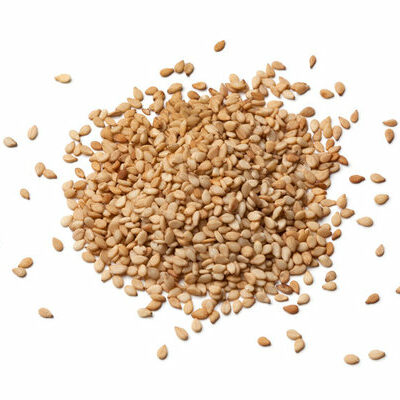
Sesame
What is Sesame?
Sesame is classified as a spice obtained from the Sesamum or benne plant in the form of seeds. These seeds may be either white or black in color or even red or brown, depending on the variety. They have a mild, sweet, and nutty flavor and a crunchy texture.
- These seeds are a basic ingredient in many Asian cuisines and are used extensively in South Indian, Middle Eastern, Chinese, Japanese, and Korean cuisines.
- Bread prepared with sesame seeds has religious and cultural significance for Jews and Muslims in many parts of the world.
The top 10 most popular sesame seed brands are:
- Happy Belly
- Terrasoul Superfoods
- JFC
- Anthony’s
- Roland Foods
- Eat Well
- Green Max
- Badia
- McCormick Culinary
- Kevala
Origin of sesame
These seeds most likely originated in the Sunda Islands of Indonesia and have a history of cultivation spanning more than 4,000 years. They are one of the oldest oilseed plants that humans cultivated and were first domesticated in the Indian subcontinent. The oldest archaeological remains of this spice were found at Harappa site in Pakistan. These seeds were used by the Babylonians and ancient Egyptians since around 1500 BC. Also, they spread into China at this time, from where they eventually spread throughout Central Asia. Wild sesame, however, originated in Africa.
Nutrition
Nutritional profile for sesame (1 tbsp):

Sesame has antioxidant and anti-inflammatory properties, which can help in reducing the risk of cardiovascular diseases and atherosclerosis. Regular consumption may also help in controlling the risk of hypertension, thrombosis, diabetes, and obesity. Also, these seeds are useful for increasing the bioavailability of vitamin E.
Traditionally, they have been used in Iranian Traditional Medicine for menstruation problems. In addition, they were a vital component of Chinese Traditional Medicine for skin care, women’s health, and for healing wounds. In Ayurveda, they were used as a medicine for liver and kidney problems and blood nourishment.
Commercial production
The main sesame producing countries are Myanmar, India, Tanzania, Nigeria, China, Ethiopia, Burkina Faso, South Sudan, Chad, and Uganda. In the US, most sesame farmers work for Sesaco Corporation, an American company based in the state of Texas.
The plants that produce these seeds thrive in well-drained soils with a neutral pH. Moreover, they require five frost-free months for production and provide higher yield in hotter conditions. This crop is drought resistant, but has shown to produce more seeds with an irrigation system.
Sesame seeds should be stored in an airtight container in a dry and cool place, away from sunlight. If stored under optimum conditions, they can remain fresh for up to 6 months.
Sesame recipes
These seeds are an important component of several Asian cuisines. Oil made from them is extensively used in Chinese and Indian cooking. Tahini, a traditional Middle Eastern paste, is also made from this spice. Other major uses include the preparation of halva, hummus, zaatar spice, and ajonjoli. These seeds are useful in making sweets, stir-fries, and work well as a condiment for different dishes. Overall, they are a versatile ingredient that can be used in multiple ways. Here are some recipe to try:
- Ellu Sadam
- Ellu Urundai
- Ellu Kuzhambu
- Muah Chee
- Sambal Tuna Tartare
- Kuih Bakar
- Rojak
- Kimchi
- Beef Bulgogi
- Semesmeyeh
- Kubez el Tahini
- Barazek
- Milk Toffee
- Beniseed Soup
- Halwa Chebakia
- Waakye
- Lomo Saltado
- Chaufa
- Cemitas
- Giuggiulena
FDA regulations
Sesame falls under the generally recognized as safe category. These seeds are classified under spices and other natural seasonings. They have recently been declared as a major allergen and the FDA has issued guidelines for disclosing sesame as a component in food.
References
Sesame Profile, Agricultural Marketing Resource Center (AgMRC), https://www.agmrc.org/commodities-products/grains-oilseeds/sesame-profile
Sesame, Silk Routes: Heritage, Trade, Practice, The International Writing Program, The University of Iowa, https://iwp.uiowa.edu/silkroutes/sesame
Dalibalta, Sarah et al. “Health benefits of sesamin on cardiovascular disease and its associated risk factors.” Saudi pharmaceutical journal : SPJ : the official publication of the Saudi Pharmaceutical Society vol. 28,10 (2020): 1276-1289. doi:10.1016/j.jsps.2020.08.018, https://www.ncbi.nlm.nih.gov/pmc/articles/PMC7584802/
